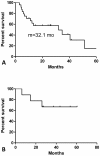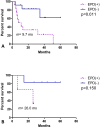Hypofractionated radiotherapy for primary or secondary oligometastatic lung cancer using Tomotherapy
- PMID: 23268786
- PMCID: PMC3552755
- DOI: 10.1186/1748-717X-7-222
Hypofractionated radiotherapy for primary or secondary oligometastatic lung cancer using Tomotherapy
Abstract
Background: To retrospectively review the outcome of patients with primary or secondary oligometastatic lung cancer, treated with hypofractionated Tomotherapy.
Methods: Between April 2007 and June 2011, a total of 33 patients with oligometastatic intrapulmonary lesions underwent hypofractionated radiotherapy by Tomotherapy along with appropriate systemic therapy. There were 24 primary, and 9 secondary lung cancer cases. The radiation doses ranged from 4.5 to 7.0 Gy per fraction, multiplied by 8-16 fractions. The median dose per fraction was 4.5 Gy (range, 4.5-7.0 Gy), and the median total dose was 49.5 Gy (range, 45-72 Gy). The median estimated biological effective dose at 10 Gy (BED10) was 71.8 Gy (range, 65.3-119.0 Gy), and that at 3 Gy (BED3) was 123.8 Gy (range, 112.5-233.3 Gy). The mean lung dose (MLD) was constrained mainly under 1200 cGy. The median gross tumor volume (GTV) was 27.9 cm3 (range: 2.5-178.1 cm3).
Results: The median follow-up period was 25.8 months (range, 3.0-60.7 months). The median overall survival (OS) time was 32.1 months for the 24 primary lung cancer patients, and >40 months for the 9 metastatic lung patients. The median survival time of the patients with extra-pulmonary disease (EPD) was 11.2 months versus >50 months (not reached) in the patients without EPD (p < 0.001). Those patients with smaller GTV (≦27.9 cm3) had a better survival than those with larger GTV (>27.9 cm3): >40 months versus 12.85 months (p = 0.047). The patients with ≦2 lesions had a median survival >40 months, whereas those with ≧3 lesions had 26 months (p = 0.065). The 2-year local control (LC) rate was 94.7%. Only 2 patients (6.1%) developed ≧grade 3 radiation pneumonitis.
Conclusion: Using Tomotherapy in hypofractionation may be effective for selected primary or secondary lung oligometastatic diseases, without causing significant toxicities. Pulmonary oligometastasis patients without EPD had better survival outcomes than those with EPD. Moreover, GTV is more significant than lesion number in predicting survival.
Figures







References
-
- Hellman S. Karnofsky memorial lecture. Natural history of small breast cancers. J Clin Oncol. 1994;12:2229–2234. - PubMed
-
- Hellman S, Weichselbaum RR. Oligometastases. J Clin Oncol. 1995;13:8–10. - PubMed
-
- Benedict JC SH, Libby B, Lovelock M, Schlesinger D, Sheng K, Yang W. SRT and SBRT: Current practices for QA dosimetry and 3D. J Phys Conf Ser. 2010;250:012057.
MeSH terms
LinkOut - more resources
Full Text Sources
Medical
Miscellaneous

